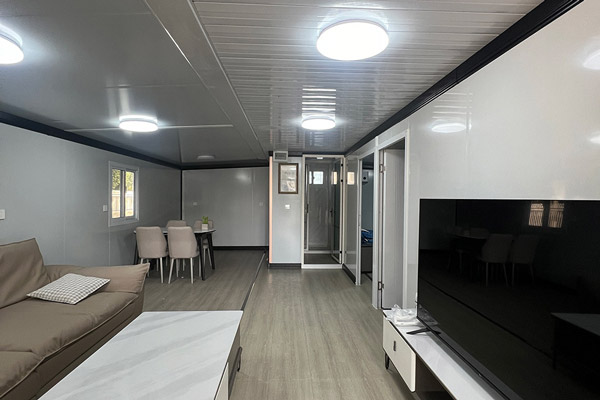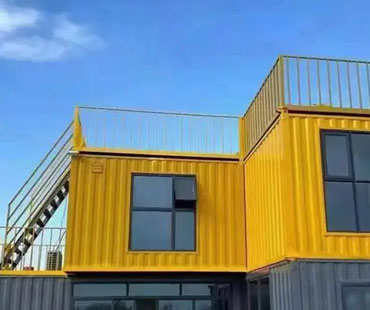In recent decades, the modernization of global trade and the rapid development of industrial supply chains have transformed the role of containers from simple cargo carriers into multi-functional structural units with wide-ranging value. What began as a standardized transport box has evolved into a versatile asset used in construction, warehousing, emergency response, temporary facilities, and modern logistics operations. Today, containers are no longer confined to shipping lines and ports; they have become an essential component of numerous industries seeking efficiency, flexibility, and cost-effective solutions. This article explores the growing importance of modern containers in construction, warehousing, and cross-border logistics, highlighting the structural advantages, economic benefits, and emerging trends driving their adoption.
1. The Transformation of Containers: From Transport Units to Multi-functional Infrastructure
The original purpose of a shipping container was simple: provide a safe, standardized, tamper-resistant space for global cargo movement. However, standardization, durability, and ease of integration have made containers ideal for uses far beyond maritime transport. Modern containers feature:
High-strength corten steel structures
Water and wind resistance
Fire-resistant materials
Standardized ISO dimensions for global compatibility
Stackability and modularity
Long service life with minimal maintenance
These attributes make containers reliable, reusable, and adaptable — qualities essential to industries where rapid deployment and structural integrity are critical.
2. The Value of Containers in Construction: Modular, Flexible and Cost-efficient
The construction industry increasingly turns to container-based structures due to tight schedules, rising labor costs, and the need for mobile or temporary facilities.
2.1. Modular Building and Rapid Deployment
Modular container buildings can be manufactured off-site, transported easily, and assembled on location. This significantly reduces:
On-site construction time
Labor requirements
Material waste
Environmental impact
Applications include:
Office units for construction sites
Worker accommodation
Safety monitoring rooms
Portable restrooms and facilities
Temporary command centers
Pop-up commercial spaces
This rapid-deployment capability is especially valuable for remote engineering sites, emergency projects, and areas with poor infrastructure.
2.2. Structural Safety and Long-term Durability
Containers are engineered to withstand harsh ocean conditions, making them durable in construction applications. Their advantages include:
High structural load-bearing capacity
Strong resistance to wind, seismic activity, and extreme weather
Long lifespan (15–25 years in building applications)
When combined with proper insulation, coatings, and engineering design, container structures provide safe and long-lasting buildings for both temporary and permanent use.
2.3. Sustainability and Reusability
Reusing decommissioned containers helps reduce construction waste and supports green building initiatives. Many companies choose container architecture to achieve environmental goals such as:
Lower carbon footprint
Reduced material consumption
Adaptability for future relocation or expansion
This sustainability aspect aligns with global trends in eco-friendly construction.

3. The Role of Modern Containers in Warehousing: Enhancing Efficiency and Space Utilization
Warehousing operations rely heavily on flexible and scalable storage solutions. Containers have become indispensable due to their strong adaptability.
3.1. On-demand Storage Capacity
Businesses experiencing seasonal demand peaks — such as agriculture, retail, manufacturing, and e-commerce — utilize containers to expand storage capacity rapidly without investing in permanent warehouses. Containers offer:
Ready-to-use enclosed storage
Weatherproof protection
Security with lockable doors
Easy relocation when no longer needed
This flexibility makes them ideal for small and medium-sized enterprises seeking temporary or mobile inventory solutions.
3.2. Cost-effective Inventory Protection
Compared to building traditional storage facilities, container warehousing requires:
Lower upfront investment
No land development
Minimal maintenance
Fast setup and removal
Containers can store machinery, raw materials, chemicals (with modifications), and finished goods safely, helping companies protect valuable assets while controlling storage costs.
3.3. Modular Warehouse Clusters
For industries needing larger storage areas, multiple containers can be arranged into:
Multi-unit storage complexes
Temperature-controlled facilities
Tool rooms and maintenance stations
Partitioned goods management zones
The modularity of containers allows warehouses to scale gradually as business needs evolve.
4. The Importance of Containers in Cross-border Logistics
Cross-border logistics depends heavily on efficiency, security, and standardization — qualities that modern containers are perfectly designed to support.
4.1. Standardization Supports Global Freight Integration
Modern containers are built according to ISO standards, enabling seamless transfer between:
Ships
Trucks
Railways
Storage yards
This intermodal compatibility streamlines global supply chains and reduces the risk of cargo loss or damage.
4.2. Security and Compliance in International Trade
Containers provide sealed, tamper-evident transport units that help companies meet customs inspections and international regulations such as:
CTU Code
ISPS security requirements
Customs sealing guidelines
Their secure structure reduces risks of theft, smuggling, and contamination, ensuring cargo integrity across borders.
4.3. Enhanced Efficiency in Long-distance Transport
Containers enable:
Faster loading/unloading
Reduced labor costs
Improved route planning
Lower risk of cargo delays
For industries like electronics, automotive parts, chemicals, textiles, and food products, containers ensure reliable delivery schedules across global markets.
5. Emerging Trends: Smart Containers and Sustainable Global Trade
The container industry is undergoing technological upgrades, ushering in new opportunities.
5.1. Smart Containers
Equipped with sensors and IoT modules, smart containers provide:
Real-time cargo tracking
Temperature and humidity monitoring
Security alerts
Predictive maintenance
These features are crucial for high-value or sensitive goods such as pharmaceuticals, electronics, and perishable foods.
5.2. Eco-friendly Materials and Green Logistics
Global demand for low-carbon operations has led to:
Improved insulation materials
Solar-powered container units
Recycled-steel construction
Energy-efficient refrigerated containers
These sustainable innovations reduce environmental impact and operational costs.
Modern containers have moved far beyond their origin as simple shipping units. Their strength, standardization, versatility, and cost-effectiveness make them invaluable across construction, warehousing, and cross-border logistics. Whether enabling rapid deployment on construction sites, serving as modular storage units, or ensuring the smooth movement of goods across international borders, containers play a central role in global industrial development.
As technology evolves and industries seek more efficient and sustainable solutions, containers will continue to transform from traditional transport tools into intelligent, multi-functional infrastructure supporting the next generation of global commerce.


